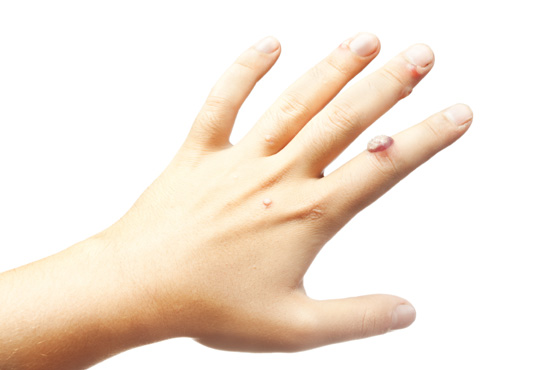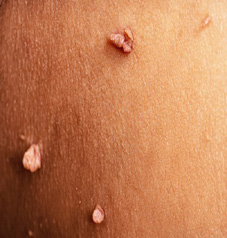WART

What is a Wart?
Warts are benign (noncancerous) growths that appear on the skin and mucosal surfaces. These growths are triggered by a virus called the Human Papilloma Virus (HPV). These lesions typically form superficially, i.e., at the level of the epidermis (the topmost layer of skin), and can have various morphological characteristics.
What are the Symptoms of Warts?
Warts are typically painless and are characterized by a distinct tissue surface elevation. They are generally round or oval in shape and can be white, gray, brown, or skin-colored. Warts can have a distinct striated or granular (grainy) surface morphology.
How are Warts Formed?
Warts form when HPV penetrates cells as a result of contact with the skin or mucosa. The virus stimulates the skin cells to proliferate uncontrollably, leading to the characteristic surface bump of the wart.
Where do Warts Appear?
Warts can appear almost anywhere on the body but are most commonly seen on the hands, feet, and genital area. The location where warts appear is typically the point of entry for the virus into the body.
How are Warts Spread?
Warts are typically spread through direct contact. This means skin-to-skin contact with an infected individual, or when a person touches an object that carries the virus. Warts can also spread by infecting a nearby location on the body from where they are situated.
What are the Different Types of Warts?
There are many different types of warts, including flat warts, plantar (foot) warts, filiform (thread-like) warts, and genital warts. Each type is determined by its morphology, location of occurrence, and typically the type of HPV causing it.
How are Warts Diagnosed?
Warts are typically diagnosed through a physical examination. Tools used to inspect under the skin, such as a dermatoscope, can be used to better ascertain the nature and structure of the wart. Rarely, a biopsy or an HPV test may be needed.
How are Warts Treated?
The different methods used in wart treatment depend on the patient's overall health condition, the location and number of warts, and the type of wart. Here are the most common treatment methods:
How Can Warts Be Prevented?
Prevention of warts generally involves limiting direct contact with infected individuals and their items, as well as maintaining skin integrity. Additionally, a vaccine can be used against genital types of HPV.
What is the Likelihood of Warts Recurring?
Warts carry a risk of recurrence despite appropriate treatment. This recurrence risk can vary depending on the treatment method used, the patient's specific risk factors, and immune status.
The treatment method used is a factor that affects the likelihood of warts recurring. For instance, some treatments (such as laser treatment or surgical methods) can reduce the risk of recurrence compared to others, but no treatment can completely eliminate the risk of recurrence.
The patient's lifestyle and behaviors also affect the likelihood of warts recurring. Factors such as continuing to smoke and engage in certain risky sexual behaviors make the recurrence of warts more likely. Also, the condition of the immune system in the body can affect the likelihood of warts recurring. For example, warts recur more often in people with a disease that weakens the immune system.
However, in a particular study, warts recurred in more than half of the patients who had certain risk factors and were treated with cryotherapy, three months after treatment. If this group of patients continue their risk behaviors, it has been reported that warts recurred 4-6 times within a year. This may apply to every type of wart, but risk factors and recurrence rate may vary.
Do Warts Carry a Cancer Risk?
Most warts are harmless and mainly cause cosmetic concerns. However, most of these are caused by types of HPV (Human Papilloma Virus), and certain types of HPV can lead to various types of cancer.
High-risk HPV types include HPV 16 and 18, which can particularly lead to cancers of the cervix, vulva, vagina, penis, anus, mouth, and throat. However, these types generally form flat, invisible lesions, not genital warts. Thus, lesions typically formed by types HPV 16 and 18 have no relation to skin or genital warts.
On the other hand, skin warts are usually caused by low-risk HPV types, and these types have an extremely low risk of leading to cancer. Although the risk of skin warts turning into skin cancer is extremely low, if a wart does not go away for a long time, grows, or bleeds, it is important to have it checked by a doctor specializing in warts.
In children, the incidence of warts is common, and treatment should be the same as adults. However, the choice of treatment depends on the child's age and general health condition.
What is the HPV Vaccine and How Does It Work?
The HPV vaccine triggers the body's immune response against certain types of Human Papilloma Virus (HPV), helping to prevent a range of diseases caused by this virus. There are two main HPV vaccines: quadrivalent (4-valent) and nonavalent (9-valent).
The Relationship Between Warts and the Immune System
HPV enters skin or mucosal cells and stimulates these cells to proliferate uncontrollably. This proliferation process leads to the formation of a wart. The immune system protects the body by targeting and eliminating viruses and bacteria. This process is the same with warts caused by HPV. The immune system recognizes HPV and tries to eliminate the virus.
However, warts are typically found in the top layer of the skin, which complicates the immune system's full intervention with the virus. Because warts do not enter the bloodstream, they do not trigger the body's general immune response. In other words, the body is generally not aware of the presence of an HPV infection.
This situation can lead to the immune system being insufficient in completely eliminating warts caused by HPV. As a result, this virus can sometimes become permanent in the cells and cause recurrent warts. Therefore, when a wart is treated, the infection caused by HPV may not completely disappear, increasing the risk of recurring warts.
This article may also interest you

Condylomas, also known as genital warts, are benign (non-cancerous) tumors caused by the human papillomavirus (HPV).
Read more

 TR
TR EN
EN